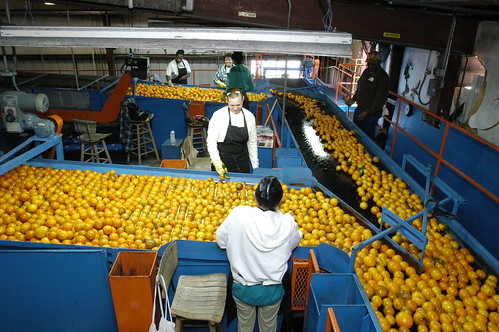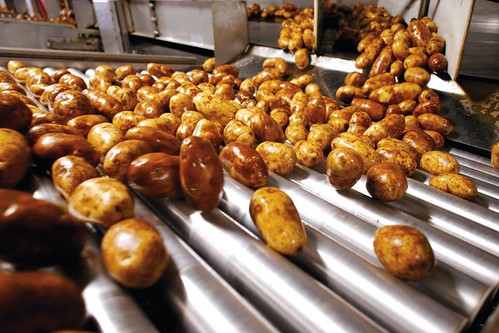
When products do not meet a marketing order’s quality standards but are still edible, they can be diverted to secondary markets to minimize food waste while increasing producer returns. USDA photo courtesy of Ken Hammond.
USDA’s Food Waste Challenge is underway and federal marketing orders for fruits and vegetables continue to help out in the food donation effort. Under these industry self-help programs that are overseen by the Agricultural Marketing Service (AMS), groups decide minimum quality standards that benefit the entire industry. When products do not meet a marketing order’s quality standards but are still edible, they can be diverted to secondary markets to minimize food waste while increasing producer returns.
When this occurs, businesses have a couple of options: send the food to the processed market, donate the food to charities and food banks, or process the food into livestock feed. Nearly half of the active fruit and vegetable marketing orders also include comparable import regulations to ensure foreign products meet the same quality standards as those produced domestically.
There are several examples of how marketing orders provide consumers with a supply of consistently high quality product while utilizing secondary markets. Both the Florida Citrus Marketing Order and the Idaho-Eastern Oregon Potato Marketing Order require products to meet minimum quality standards that include size, shape, appearance and maturity. The standards, which align with factors customers consider when making purchases, are verified by USDA inspectors before products are shipped to the supermarket or food service customers.
As Florida citrus is sorted in packinghouses, all misshapen, off-sized, blemished and immature fruit is separated for secondary markets. Most of this sub-standard fruit is diverted to processing into orange and grapefruit juice. Approximately 5 to 10 percent is sold to roadside vendors or donated to local charities and food banks. George Hamner, chairman of the Citrus Administrative Committee (CAC), stressed, “The rules and parameters set by the CAC provides market stability while ensuring that consumers have a consistent quality standard for any fresh citrus fruit sold in the produce section of a grocery store or any other retail outlet.”

In the potato industry, USDA graders verify that potatoes in packing facilities meet quality standards for the Idaho-Eastern Oregon Potato Marketing Order. Potatoes not meeting the order’s quality standards are diverted to the processed market. Photo courtesy of the Idaho-Eastern Oregon Potato Committee.
In the potato industry, USDA graders verify that potatoes in packing facilities meet quality standards created and approved by the Idaho-Eastern Oregon Potato Committee. Potatoes meeting the highest quality standards are called No.1 potatoes and sent to the produce aisle. Potatoes not quite No. 1 are called No. 2 potatoes and are most often sent to restaurants for “fresh-cut fries.” About 65 percent of the potatoes that enter the packing shed fit into a No. 1 or No. 2 category. The other 35 percent of misshapen, off-sized, blemished or immature potatoes are diverted to the processed market. The majority of these potatoes are made into dehydrated potatoes, fries, or hash browns. Travis Blacker, manager of the Idaho-Eastern Oregon Potato Committee, emphasized, “Overall the process of having federal marketing order quality standards produces little to no waste in the Idaho-Eastern Oregon potato industry. This helps growers provide consumers with high quality potatoes and potato products.”
Importers of products with established marketing orders regulations have the same opportunity to divert substandard fruits, vegetables or specialty crops to secondary outlets. In 2014, importers sent more than 656 million pounds of produce to be processed into sauces, dips, fry products, juice and other processed products. Another 1.8 million pounds of imported fruits, vegetables and specialty crops went to food banks and charities in 2014.
Thanks to federal marketing orders, the produce industry is stepping up to USDA’s Food Waste Challenge. The allocation of product begins at the producer and handler level, enabling almost all of the produce to enter a primary or secondary market. USDA is proud to work with the industry to minimize food waste, a win-win for us all.

The majority of fresh Florida citrus products that do not meet quality standards are processed into orange and grapefruit juice. Approximately 5 to 10 percent is sold to roadside vendors or donated to local charities and food banks. USDA Photo Courtesy of Scott Bauer.
No comments:
Post a Comment
Note: Only a member of this blog may post a comment.